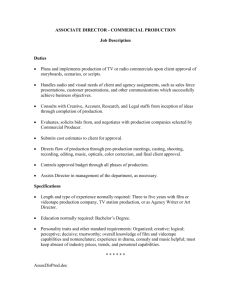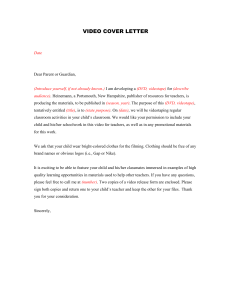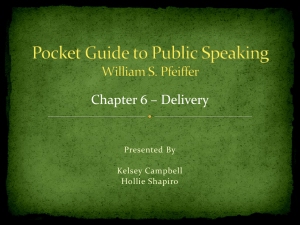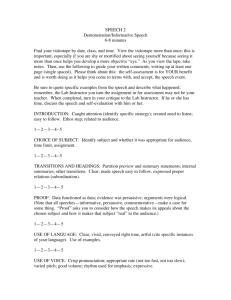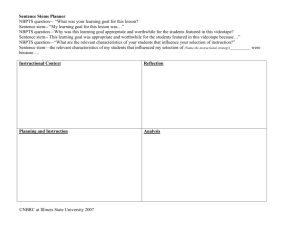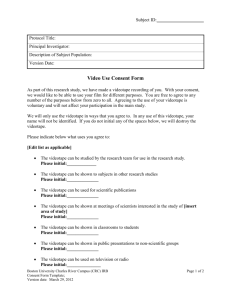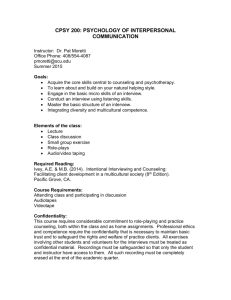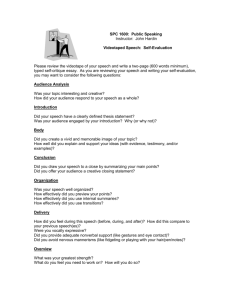1 by A.B. Cornell University
advertisement
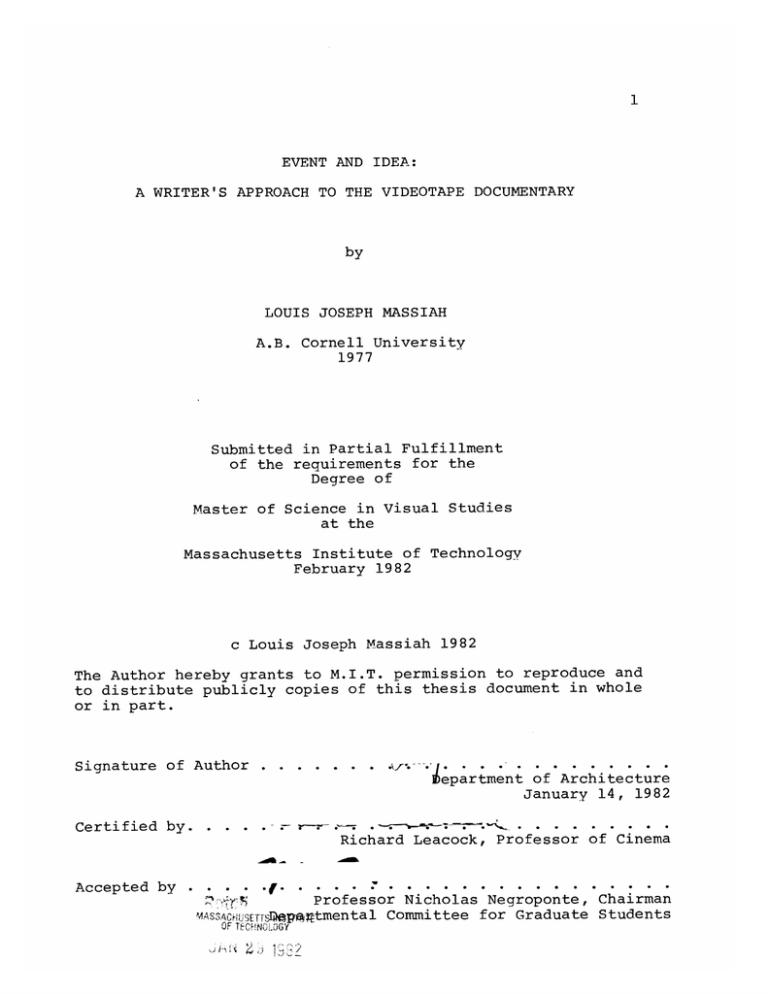
1 EVENT AND IDEA: A WRITER'S APPROACH TO THE VIDEOTAPE DOCUMENTARY by LOUIS JOSEPH MASSIAH A.B. Cornell University 1977 Submitted in Partial Fulfillment of the requirements for the Degree of Master of Science in Visual Studies at the Massachusetts Institute of Technology February 1982 c Louis Joseph Massiah 1982 The Author hereby grants to M.I.T. permission to reproduce and to distribute publicly copies of this thesis document in whole or in part. Signature of Author .......... Separtment of Architecture January 14, 1982 Certified by. . . . . .. r-r-, -. .......... Richard Leacock, Professor of Cinema Accepted by . . . .. . . . ..-.-.-.-.-.-.-.-.-. - -. . - -' - Professor Nicholas Negroponte, Chairman MASSACH SETESQptmental OF TECHNOLOGY LIBRARIES Committee for Graduate Students MfIlLibraries Document Services Room 14-0551 77 Massachusetts Avenue Cambridge, MA 02139 Ph: 617.253.2800 Email: docs@mit.edu http://libraries.mit.edu/docs DISCLAIMER NOTICE The accompanying media item for this thesis is available in the MIT Libraries or Institute Archives. Thank you. 2 Event and Idea: A Writer's Approach to the Videotape Documentary by Louis Joseph Massiah Submitted to the Department of Architecture on January 14, 1982, in partial fulfillment of the requirements for the dearee of Master of Science in Visual Studies. ABSTRACT The documentation of ideas has been the basis of my interest in videotape recording. Thoughts, notions and other things from the head often have a dynamic visual and aural nature, which suggests the technology of videotape might be used as a means for presenting ideas. I have attempted to borrow techniques from writing in order to find an approach to producing movies. of an idea-oriented movie, The image script Washincton Rector, is included. Thesis Supervisor: Richard Leacock Title: Professor of Cinema Excerpts from Washington Rector are included on a twenty minute 3/4" videotape cassette.(sound, color, and dialogue in English) 3 TABLE OF CONTENTS page ABSTRACT 2 DEDICATION 4 ACKNOWLEDGEMENTS 5 IDEA TO IMAGE 7 IMAGE S"RIPT: 12 WASHINGTON RECTOR 18 APPENDIX: PRODUCTION NOTES FOOTNOTES FOR WASHINGTON RECTOR 20 4 To my mother, for her love and support form the beginning; guides me. and to my father, whose spirit still 5 ACKNOWLEDGEMENTS There are many people who I must thank, whose help and guidance have gotten me to this point: Lygeri Koromvokis has helped and advised me from the first productions, her presence has been a source of strength; Freida Jones has leant artistic insight and technical assistance to three documentary productions; a great help in making me more comfortable with videotape technology has been Benjamin Bergery, the primary cameraperson for Miami Journal; I am grateful to Rachel Strickland whose patience and eneray wher my chief assets in Rector. shooting Washington Richard Leacock, my advisor at M.I.T,, has opened up a whole new genre of movie making to me by making beautiful films. The staff of the Film/Video section at M.I.T. are the people I must thank for helping me get all videotape productions off the ground -- specifically Mark Abate, the engineer; Diane Bohl, who was always there at those frequent times of crisis; Hannah Silverman and Lynn Silverman, except in no relation their commitment to movie making and and willingness to help graduate students. 6 I am grateful to Diana Edmonds for her hospitality during the shooting of Washington Rector in New Ellis York. through his words and works, Haizlip, has aided me in the transition from the verbal to the visual by helping me to appreciate the richness of the life around me. I thank Antonio Muntadas for introducing the concept of the 'video landscape' to me. My monitor throughout most of my time in Boston, the one person who sat through all the early edits and encouraged me with patience been David Meacham. I and enthusiasm has am grateful to him for keeping me cognizant of the social responsibility And finally, I Frederica and Allen, thank my sister and brother, for their support and my uncle, Benjamin Massiah, whose generosity.allowed me to produce Miami Journal. IDEA TO IMAGE 7 Like DaVinci and those believers in the "Golden Mean", I have held the belief that artistic express- ion should offer the viewer insight into the basic nature.of things, a glimpse at the truth of our world. Growing up in the 1960's, inan age where greater understanding of the physical nature of matter had helped create a technologically oriented society, my first interest was in trying to understand fundamental physical processes. As a student I was intrigued by those elegant laws of physics and matter which seemed to give great order and harmony to an otherwise unmanageable world. When later I came across the writings of diverse theorists -- the cosmologies of Thomas Gold and John Wheeler, Ilya Prigogine's Dissipative Structures -- there was again a feeling of delight. Though at times the complexity of the writings and the mathematical derivations seemed abstruse, I found contentment in those moments of profound understanding that would sometimes occur. v impulse was to find a medium in which these ideas and others like them might be presented to a larger audience, particularly people who might not have access to the writings from which these ideas came. 8 The search for this medium and approach, tempered by the qualification that my job was not only to express profound and elegant concepts, but concepts that were in fact true, led me to consider the videotape documentary. Borrowoing greatly from Berekelev in describing the thought process: General ideas must be drawn particular percepts; those abstract or general ideas which have no perceivable manifestations in the real world are useless. 1 Thus videotape, as a means of documenting perceivable images and sounds, might be edited to express the visual and aural nature of thought. The medium of videotape has attributes that make it an appropriate choice for presenting ideas and issues. The most important of these qualities is the perception that videotape provides a true, objective .record. This view is very much due to the origins of videotape in the television industry. News, sports coverage, talk shows, concerts, all 'live' and 'real' formats, are recorded on tape, usually with a great deal of standardization in the camera work and editing. Videotape is presented as a truthful record of an event, fr'ee 9 of bias. 2 Most people, including the vast majority of workers in the television industry, do not consider videotape technology as part of a craft or art form, but a process for recordinq an actuality. Because videotape is seen as having the cold objectivity of technology, their is not as much distancing on the part of the audience as with other, more obvious media. Video is often invisble, undifferentiated from a live, real-time event. My attempt at achieving the sensation of cognition from the videotape documentary is based on the similarity between video images and the real images that we perceive. Julian Hochberg, in discussing the perception of motion pictures, compares the rapid succession of images to "a surrogate of the scene or event being portraved."3 The array of patterned light presented on the video screen is essentially the same as what would be seen if the viewer were at the actual event. 4 Since the images of thought originate from things that have been perceived, the videotape images take on certain similarities to the thinking process. Lionel Trilling calls this :quality in motion pictures 'cogency', for there is the appearance of thought, allowing the viewer the pleasure of feeling that there is understandincr. 5 10 In 1977 and 1978 I was working in the broadcasting department of WNET/TV in New York. I was hired as a continuity writer, but to lessen the monotonous nature of the work I was allowed to produce a ~ bi-weekly science news report. The program, Science View, was about five minutes long. It would start off with a timely news item, such as announcement of Nobel prize winners, a UNESCO report on the Sahel drought situation, of a new enzyme, or the discovery and then attempt to explain the scientific principle behind the story. The report, which was broadcast live with the evening news, was primarily a 'talking head presentation, with illustrations from slides and occassional pre-recorded graphic animations. Though the - broadcast succeeded in presenting a variety of important scietific ideas, a graet proportion of the information was in the narration, not in the visuals. The process of writing and producing those segments made clear some of the problem of visualizing an idea; still, within the scripts could be found some of the ingredients which would be needed in developing an approach: establishment of topic and relevance, evidence, analogy, scale of phenomenon. 11 During my time at the M.I.T. Film/Video Section, I made two videotape documentaries. The first, Miami Journal, which was shot during the summer of 1980, is a documentary concerned with the situation of Haitian refugees in the South Florida area. The issue of injustices in the United States immigration policy are addressed in the movie. Washington Rector, the second documentary, is my first attempt at a visually oriented idea movie. In it, I try to recreate through images and structure the thoughts and feelings I have about big cities, and Manhattan in general. What follows is an image script, an attempt to describe before shotingithe type 6.f images I would attempt to find in making the movie. 12 IMAGE SCRIPT: .WASHINGTON RECTOR For the past three years I have made regular visits to the intersection of Washington and Rector Streets in Lower Manhattan. My visits to this place were almost daily while I lived in New York and once or twice a month in the time that I have been in Cambridge. I have kept a journal of these visits since August of 1978, which describe my fascinationperhaps preoccupation - with this particular intersection, The aspects of Washington and Rector Streets that I set out to explore in the videotape were the drama of the architectural space, the people of the area, and the on-going urban fables that can be witnessed at this unique American intersection, The four views from the center of the intersection are extraordinary: four scenes in a visual drama, created by the randomness of urban evolution. To the east, four blocks away at the end of Rector Street is the Irving Trust Building, a layered skyscraper, designed by Voorhees, Gmelin and Walker in 1932. The Irving Trust building has become the quintessential Wall Street financial building. Its distinctive. form has been used in caricatures of American - rd 13 financial institutions in film, comic books, and in Broadway stage design. (The Irving's street address is, in fact, no. 1 Wall Street.) In the same direction along Rector Street, on the left hand side, stands the heavy brown walls and wrought iron fence of Trinity Church -- dark spire rising in the midst of a limeston canyon. Looking northward from the intersection stands the colossus of Two World Trade Center, which forms a magnificent end to Washington Street. The World Trade Center has become the spiritual Mt. Fuji for New York City, visible just about everywhere. The approach at short range.from this intersection is particularly awesome. The transported facade I L c- of an Ed.o period tempe, V-LL% .- now the entrance a fashionable Japanese restaurant, LL% way to stands about half a block from Rector Street, toward the World Trade Center. Across the street from the restaurant is St. George's Chapel, a minature Byzantine Church. The western view along Rector Street leads quickly to the deserted West Side Highway, on block away. The entrance and exit ramps criss-cross the narrow vista of the street. The grey waters of -the Hudson River appear through the columns and supports of the overpass. At night, mercury vapor lights 14 atop the ramps add a curious air of pink sweetness and floodlight desolation. One block south on Washington Street is the Battery Parking Complex, a huge concrete structure that is raised above an entrance way to the BrooklynBattery Tunnel. The street ends abruptly and is changed into a no-man's land by the darkness of the parking lot and steady drone of automobiles, drifting up from beneath. The Parking Complex itself looks like a massive cement mixer in stilts. These architectural forces create a powerful ambiance for Washington and Rector. The combined effect of four obstructed crossroads and the sparcity of light, due to the ring of towering buildings in the area, create the impression of being deep inside a closed pocket of a huge urban beast. The location of the intersection, one block from the Hudson River and the coldness of the parking lot produces a feeling of desolation - being trapped in an unwatched corner of town. The street level activity in the area includes cars, bicycles, and surprisingly few pedestrians, compared to most areas in downtown Manhattan. The businesses on the ground floor include courier services, coffee shops, additional parking facilities, and, most prominently, Giovanni's Atrium, a 'large 15 Italian restaurant, more known for the liquor selection than the cuisine. The bar is one of the more famous meeting places for clandestine office affairs, often interracial, in the financial district. It is not an unusual sight to see well dressed secretaries pile their inebriated bosses into one of a line of taxi-cabs that wait outside the bar. There have been occassional brawls when a wife or husband has come to retrieve a spouse from this establishment. At night, when the neighborhood empties out, the Atrium oozes its own particular form of vibrancv into the area. During the day, the young men who work at the messenger services gather on the sidewalk between errands, resting their feet on the high pressure hydrants. They talk about women, sex, politics; smoke marijuana, and complain about the fumes from the Brooklyn Battery Tunnel and parking lots. On the bank plaza, located on the southwest corfter of the intersection, they occassionally mingle with the temporary office workers, watching the bicyclers and joggers on the West Side Highway. George's Restaurant, located on Rector Street, is a glass walled coffee shop that feeds many of the workers in the area. It is known as the poor man's restaurant in the financial district, a spot most popular on the day before pav day. Most of the 16 customers are black, Hispanic or foreign born men in their thirties or forties who often must budget lunch in order not to spend their subway fare home. George's, needless to say, is not know for its menu. Occassional credit, check cashing and a regular numbers game are what keep the customers. Their conversations are of newspaper headlines, work, bosses, vacations and debts. St. George's Chapel on Washington Street, a diminutive building, scarcely eighteen feet wide, holds service every day, except Saturday. Men and women who work in the area, as well as a few who live in the apartments above the remaining stores, attend mass. There is an incongruity when watching the variety of people who go in and out of church. A veiled woman, in a tattered coat might leave the church at the same time as a conventionally dressed attached business man. She walks to her room above a bar on Rector Street, still mumbling prayers to herself, and he walks up Washington Street to his office at one of the international banking concerns at the World Trade Center. The videotape Washington Rector captured some -of these visual and human aspects of this spot in Manhattan. The movie consists of four segments, each centered on a 'human story' in one of the four dircetions of the intersection; as well as 17 an introductory and closing segment, which provides orientation to the movie. My initial intention had been to use the geometry of the space as part of the structuring device in developing a narrative flow. Instead I found myself drawn to the verite vignettes and the structure created by real events as a more satisfying way to structure the tape. A counterpoint is the abstraction of the buildings, achieved by design and symmetries of the urban terrain, and the human stories contained within. APPENDIX PRODUCTION PLAN FOR WASHINGTON 18 RECTOR The videotape will be recorded between March 23rd, 1981 and March 28, 1981. The production will require a crew of two people, with perhaps a third person, a facilitator joining in New York. The bulk of pre-shooting arrangements can be completed before arriving in New York from Cambridge. Notes I have already made will be helpful in defining some of the technical parameters of the movie. Interviews will be arranged when we arrive in the area. The one major pre-production arrangement that must be negotiated before hand is obtaining passage on a helicopter to tape the intersection from overhead. Scripting should allow a 3 to 1 shooting ratio, a slightly higher ratio will be estimated for the interview and vertite sequences. I-will plan on editing the videotape immediately after shooting, with a thesis edit prepared in editing time is (March 30th to April 19th, 60 hours of 1981). This dependent on the availability of one of the two editing systems at Film/Video Section. 19 APPENDIX - PRODUCTION PLAN Estimated Cost Item Videotape - Nine 20-minute cassettes Four 60-minute cassettes (for dubs and edit) Travel to New York from Cambridge $135.00 $ 80.00 (AMTRAK)- $ 80.00 Insurance for equipment- $100.00 Automobile use while on location(parking fees, gasoline, tolls) $100.00 Food and Lodging($30.00 food per person x 2 x 7) ($40.00 a week "charity housing" x 2) $420.00 $ 80.00 Helicopter use (One hour) $150.00 Miscellaneous(telephone, xeroxing, taxies) $100.00 Estimated total $1245.00 Camera, lenses, 3/4" deck, audio equipment, lights and other euipment will be borrowed from the Film/Video Section at M.I.T. 20 FOOTNOTES 'George Berkeley, "A Treatise Concerning the Principles of Human Knowledge," from Locke, Berkeley, Hume, Reid and J.S. Mills, edited by A.J. Ayer and Raymond Winch, London: Routledge and Keenan Paul, 1952, pp. 167-71. 2.This is not to say the content of commentary and interview is accepted without doubt, only that thc images arid sound are regarded as true recordings of what was presented. 3 'Julian Hochberg and Virginia Brooks, "The Perception of Motion," from Handbook of Perception, Vol. X, New York: Academic Press, 1978. p. 261. 4. Ibid. 5.' 'Sol Worth, "Film as Non-Art: An Approach to Film," form The American Scholar, Vol.35, Number 2, p. 325
